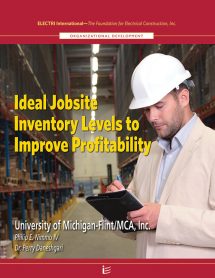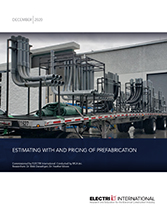Ideal Jobsite Inventory Levels to Improve Profitability
Electrical contracting is a risky business. The contractor has to constantly balance between its relationship with labor, the general contractor, distributors, manufacturers, architects, owners, banks and many other constituencies.
The main risk for the contractor is labor productivity. This research and NECA’s data show that on the average, 42 percent of the annual sales of an electrical contractor is labor cost and another 34 percent is material cost. Research also shows that electricians could spend an average of 40 percent of their time on non-value-added material handling. Non-value-added material handling is defined as any movement of material on the jobsite that does not end up in installation, such as:
- Waiting
- Unloading
- Ordering
- Sorting
- Moving to accommodate jobsite
- Returns
- Delivery mistakes
- Storage to be used later
Contractors have learned to optimize labor hours on the jobsite using daily adjustments of the number of men working. The material management, despite its large impact on labor productivity and cost, is typically left to the field personnel. Just like ideal manpower quantity, there exists an ideal material quantity on jobsites. This research shows that this number is three days of inventory at any given time. A higher number of days will increase the non-value-added portion of the material handling; alternatively, fewer days will cause labor waste due to waiting and job stoppage.
This research clearly defines the need for material planning and scheduling in order to get to the ideal levels of inventory on the jobsite. Proven collaborative partnerships between contractors and distributors are ideal for achieving the correct inventory level. The services provided by the distributors are as important as the prices they offer. By compensating distributors for services such as delivery of goods where, when and how they are needed, the contractor can even forgo cash discounts and still be more profitable. A collaborative model, which shares the financial risk between the contractor and distributor—such as pay-when- paid—will reduce risk for both parties.















